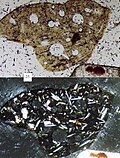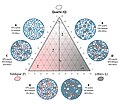Sandstone
Sandstone is a type of rock that is primarily composed of sand-sized minerals or rock grains. Most sandstone is composed of quartz and/or feldspar because these are the most common minerals in the Earth's crust. Like sand, sandstone may be any color, but the most common colors are tan, brown, yellow, red, grey, pink, white, and black.
Formation[edit]
Sandstone is formed from sediment that has been settled and compacted, and then lithified into rock. The process of formation includes:
- Erosion: The source material for sandstone is the erosion product of pre-existing rocks.
- Transportation: The eroded material is then transported by water, wind, or ice to the place where the sediment is deposited.
- Deposition: The sediment is deposited in places such as beaches, river deltas, or sand dunes.
- Compaction: Over time, more and more sediment is deposited, causing the lower layers to be compacted by the weight of the layers above.
- Cementation: Minerals in the water that the sediment is in can act as a glue or cement, causing the sediment grains to stick together and form rock.
Types of Sandstone[edit]
There are many different types of sandstone, including:
- Arkose: This is a type of sandstone that is rich in feldspar.
- Greywacke: This type of sandstone is a variety of sandstone that has a large amount of clay.
- Quartz Sandstone: This is a type of sandstone that is almost entirely composed of quartz grains.
Uses[edit]
Sandstone has been used for domestic construction and housewares since prehistoric times, and continues to be used. It is often used for construction because it is easy to work with and makes for a good building material. It is also used in the production of glass and ceramics, as well as in the petroleum industry as a reservoir for oil and gas.
See Also[edit]
Sandstone[edit]
-
USDA Mineral Sandstone
-
Moab Alcove
-
Petra Sandstone Rock-cut Tombs
-
Coral Pink Sand Dunes Sand
-
Logan Formation Cross Bedding Scour
-
Lower Antelope Canyon
-
Saunders Quarry
-
Grus Sand
-
LvMS-Lvm
-
QFL Ternary Plot
-
QFL Triangle
-
Sandstone Classification Modified from Dott, 1964
Ad. Transform your life with W8MD's Budget GLP-1 injections from $75


W8MD offers a medical weight loss program to lose weight in Philadelphia. Our physician-supervised medical weight loss provides:
- Weight loss injections in NYC (generic and brand names):
- Zepbound / Mounjaro, Wegovy / Ozempic, Saxenda
- Most insurances accepted or discounted self-pay rates. We will obtain insurance prior authorizations if needed.
- Generic GLP1 weight loss injections from $75 for the starting dose.
- Also offer prescription weight loss medications including Phentermine, Qsymia, Diethylpropion, Contrave etc.
NYC weight loss doctor appointmentsNYC weight loss doctor appointments
Start your NYC weight loss journey today at our NYC medical weight loss and Philadelphia medical weight loss clinics.
- Call 718-946-5500 to lose weight in NYC or for medical weight loss in Philadelphia 215-676-2334.
- Tags:NYC medical weight loss, Philadelphia lose weight Zepbound NYC, Budget GLP1 weight loss injections, Wegovy Philadelphia, Wegovy NYC, Philadelphia medical weight loss, Brookly weight loss and Wegovy NYC
|
WikiMD's Wellness Encyclopedia |
| Let Food Be Thy Medicine Medicine Thy Food - Hippocrates |
Medical Disclaimer: WikiMD is not a substitute for professional medical advice. The information on WikiMD is provided as an information resource only, may be incorrect, outdated or misleading, and is not to be used or relied on for any diagnostic or treatment purposes. Please consult your health care provider before making any healthcare decisions or for guidance about a specific medical condition. WikiMD expressly disclaims responsibility, and shall have no liability, for any damages, loss, injury, or liability whatsoever suffered as a result of your reliance on the information contained in this site. By visiting this site you agree to the foregoing terms and conditions, which may from time to time be changed or supplemented by WikiMD. If you do not agree to the foregoing terms and conditions, you should not enter or use this site. See full disclaimer.
Credits:Most images are courtesy of Wikimedia commons, and templates, categories Wikipedia, licensed under CC BY SA or similar.
Translate this page: - East Asian
中文,
日本,
한국어,
South Asian
हिन्दी,
தமிழ்,
తెలుగు,
Urdu,
ಕನ್ನಡ,
Southeast Asian
Indonesian,
Vietnamese,
Thai,
မြန်မာဘာသာ,
বাংলা
European
español,
Deutsch,
français,
Greek,
português do Brasil,
polski,
română,
русский,
Nederlands,
norsk,
svenska,
suomi,
Italian
Middle Eastern & African
عربى,
Turkish,
Persian,
Hebrew,
Afrikaans,
isiZulu,
Kiswahili,
Other
Bulgarian,
Hungarian,
Czech,
Swedish,
മലയാളം,
मराठी,
ਪੰਜਾਬੀ,
ગુજરાતી,
Portuguese,
Ukrainian













